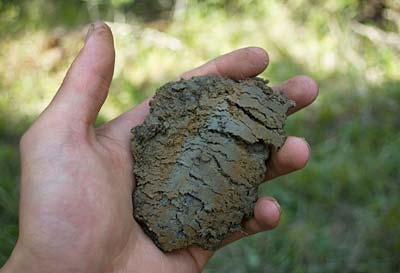
The presence of iron in different oxidation states contributes to various colorations of soils. Oxidized iron can lend red, orange and yellow soil colours, while reduced iron compounds cause a grey or bluish colored soil. | Photo courtesy of Pacific Regional Soil Science Society. This work is licensed under a Creative Commons Attribution-NonCommercial-NoDerivatives International License.
A trace element is an element whose concentration is less than 1000 ppm (0.1%) in a sample (rock, soil, or any natural product). Trace elements include:
- Trace Metals – Trace metals are metals that are present in low concentrations in air, water, soil, or food chains. Trace metals are sometimes referred to as trace elements, though the latter is a broader category.
- Heavy Metals – Heavy metals are elements that have density greater than 5.0 g/cm3, but there are also some other definitions of heavy metals – based on either atomic number or atomic weight, or chemical properties or toxicity. Examples of heavy metals are As, Cd, Co, Cr, Cu, Hg, Mn, Ni, and Pb.
- Micronutrients – Micronutrients are elements that are needed by plants in small quantities (i.e., below 50 mg/g in the biomass).
The main sources of trace elements are soil parent materials (rocks), fertilizers, biosolids, irrigation water, coal combustion residues, auto emissions, and metal-smelting industries. Even though some trace elements originate from rocks and some are essential for plant growth and development, when present in soils at elevated levels those same elements become toxic. Trace elements that have been taken up by plants, especially those grown on contaminated soils, could move up the food chain, some accumulating in the fatty tissue of animals and/or humans.
Some trace elements of potential concern as soil contaminants are: arsenic (As), boron (B), cadmium (Cd), chromium (Cr), copper (Cu), fluorine (F), lead (Pb), manganese (Mn), mercury (Hg), molybdenum (Mo), nickel (Ni), selenium (Se), and zinc (Zn).
Use this diagram to navigate to each section by clicking on each box:
TRACE ELEMENTS
![]()
![]()
Occurrence and significance of some trace elements
| Element | Source | Effects and significance |
| Arsenic | Mining by-product, pesticides, chemical waste | Toxic, possibly carcinogenic |
| Cadmium | Industrial discharge, mining waste, metal planting, water pipes | Toxic to aquatic biota. Causes kidney damage, destroys red blood cells |
| Chromium | Metal planting, cooling-tower water additive | Possibly carcinogenic as Cr(VI) |
| Lead | Industry, mining, plumbing, coal, gasoline | Toxic (anemia, kidney disease, nervous system) |
| Copper | Metal planting, industrial and domestic wastes, mining, mineral leaching | Micronutrient, toxic to plants at moderate levels |
| Zinc | Industrial waste, metal planting, plumbing | Micronutrient in many metalloenzymes, but toxic to plants at higher levels. Major component of sewage sludge |
References and Resources:
- Carter, M.R., and E.G. Gregorich (eds). 2008. Soil sampling and methods of analysis. 2nd ed. Canadian Society of Soil Science, CRC Press and Taylor & Francis Group. Oxford, UK.
- Kabata-Pendias, A, and and H. Pendias. 2001. Trace elements in soils and plants. 3rd ed. CRC Press, Boca Raton, Florida.
- Nicholson, F.A., S.R. Smith, B. J. Alloway, C. Carlton-Smith, and B. J. Chambers. 2006. Quantifying heavy metal inputs to agricultural soils in England and Wales. Water and Environment Journal 20(2): 87-95. Available at: http://www3.interscience.wiley.com/cgi-bin/fulltext/118593388/PDFSTART
- Sparks, D.L. (ed). 1996. Methods of Soil Analysis: chemical methods. Part 3. Soil Sci. Soc. Am. Book Series No. 5. ASA-SSSA, Madison, WI.
- Westerman, R.L. (ed) 1990. Soil Testing and Plant Analysis. 3rd edition. ASA-SSSA, Madison, WI.